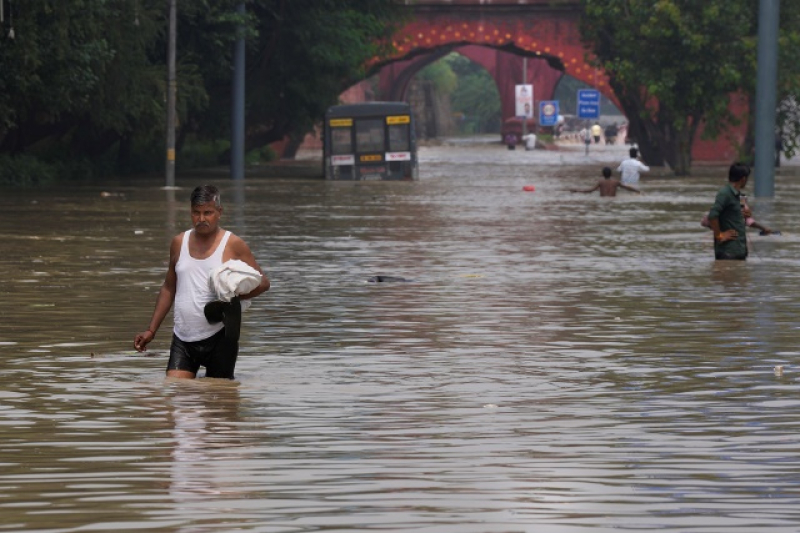- Brazil Launches Fund to Protect Forests and Fight Climate Change |
- UN Warns Conflicts Are Devastating Ecosystems Worldwide |
- Flood-hit Kurigram char residents see little hope in politics, elections |
- Air quality of Dhaka continues to be ‘unhealthy’ Friday morning |
- BNP pledges to implement signed July Charter |
Man-Made Reasons That Make Flood A Disaster

People wade through a submerged street following heavy rainfall in New Delhi, India, Thursday, July 13, 2023. Photo AP
July 17, 2023 SANDRP
Over the past 10 days, several Himalayan and North Indian states including national capital Delhi have been battling severe flood disaster which has already taken a heavy toll of human lives apart from displacing people in large numbers and causing massive scale and still unfolding destruction to public-private infrastructure which is still unfolding.
While at macro level the impact of climate change induced excessive and abnormal rainfall patterns is seen as a major culprit but the micro level analysis reveals the deep connection of human activities behind the devastation on ground.
For example, in Himachal and Uttarakhand it is increasingly becoming clear that the large-scale construction and widening of improperly designed and poorly executed highways projects have started proving a double whammy for the fragile hills and river systems.
One hand the sensitive hills have been exposed by the unscientific cuttings causing more frequent and deadly landslides along the routes and on the other hand the debris and muck generated in gigantic volume is being pushed down into the water streams and rivers. As a result, the muck and debris loaded rivers are unleashing unimaged flood wrath along their paths.
These states are also seeing mushrooming of unsustainable tourism facilities and floods of tourists’ that too during the active monsoon season and way beyond the carrying capacity of hill stations and pilgrims.
Then the incidents of dam induced floods, some of which are listed below, are only on the rise in Himachal Pradesh, Uttarakhand, Assam and Punjab states.
In plains, the common factors behind breaching of embankments over a dozen places along Ghaghar, Sutlej, Yamuna are encroachment of rivers channel, decline in flood carrying capacity of the rivers and excessive riverbed mining activities during lean season.
The reports also highlight how building residential colonies on water bodies, channels and dried river beds as key reasons for water deluge invading Chandigarh, Mohali, Panchkula, Faridabad and Noida city areas. In the case of Srinagar, the manner in which the flood restoration project is being implemented, it could well turn into a disaster itself.
YAMUNA FLOODS July 2023
Why Unprecedented Yamuna Water Levels even at moderate releases? The present unusual flood situation in Delhi and unexpected rise in Yamuna water level at ORB is more due to anthropogenic reasons some which are discussed above warranting a complete overhaul in the prevailing approach through which the floodplain and river are seen and managed by the all concerned government departments in the national capital. https://sandrp.in/2023/07/16/delhi-july-2023-possible-reasons-key-lessons-from-unprecedent-floods-in-yamuna/ (16 July 2023)
Talking point: why are Indian cities so vulnerable now to extreme climate changes? On RAJDEEP SARDESAI show on July 13, 2023, 9 pm. DIscussants includes Dr K T Ravindran, Arunabha Ghosh and Himanshu Thakkar of South Asia Network on Dams, Rivers and People (SANDRP). https://www.youtube.com/watch?app=desktop&v=xbxyl7iWanw (13 July 2023)
This excellent NDTV report from Sushil Bahuguna and Sanket Upadhyay on Delhi Yamuna Floods on July 13 2023 includes a byte from SANDRP Coordinator from 22.20 to 24.35 minutes. https://www.youtube.com/watch?v=7O68BMTRUSs (13 July 2023)
Himanshu Thakkar on NDTV: दिल्ली में Yamuna के बहाव में बाधाएं बाढ़ का कारण https://www.youtube.com/watch?v=KoJ4kEIih-Q (15 July 2023)
The real reason behind Delhi flood is not extreme weather event or record rainfall…. It is mainly poor urban planning and obstruction in the course of the river (water). Eliminating wetlands and lakes. Renowned river expert Manoj Misra had given this warning two years ago. Manoj Misra is no more. He left us a few week ago but Hridayesh Joshi is reminding us of his prophetic words on this occasion. https://www.youtube.com/watch?v=TvANdIyrOns&t=200s (15 July 2023)
“The surprising thing this time is that the peak volume of water being discharged from upstream is comparatively lower than previous years. But Delhi and Haryana’s catchment areas recorded heavy rain and encroachments on the river bed and floodplains have increased constricting the river’s flow. There are several flyovers and bridges which impact the flow and concretisation has also increased. Silt and muck accumulation in the river has also caused it to flood,” said Himanshu Thakkar, coordinator of SANDRP. https://www.hindustantimes.com/india-news/unprecedented-floods-in-delhi-climate-crisis-young-mountain-range-and-mindless-infrastructure-projects-to-blame-101689276438322.html (14 July 2023)
Yamuna flood fury: How Delhi ate into its floodplains bridge by bridge Environment experts are worried about the impact of these encroachments on the river ecology. “The 22 km stretch between Wazirabad barrage and Okhla barrage has three barrages and 26 bridges for roads, railways, metro and Regional Rapid Transit System or RRTS. The multiple bridges have fragmented the floodplains and affected the spread of flood water during monsoon,” says Bhim Singh Rawat, associate researcher, SANDRP.
The damage does not stop there. All of Delhi’s bridges are meant to have a span of 500 m to allow 12,000 cubic metres per second flow of water below it.
While the actual bridges meet the 500 m rule, the approach roads to the bridges are also built on the floodplains, aligned perpendicular to the flow of the river, extending the effective span impacting the river. “These bridges facilitate official, illegal encroachments of the riverbed vis-a-vis creation of approach roads and guide bunds to protect the bridge structures, grabbing of large floodplain area in lieu of space for maintenance facilities and dumping of construction material. These, too, result in negative impact on the river ecosystem,” Rawat adds. https://www.news9live.com/india/yamuna-flood-fury-how-delhi-ate-into-its-floodplains-bridge-by-bridge-2210846 (12 July 2023)

